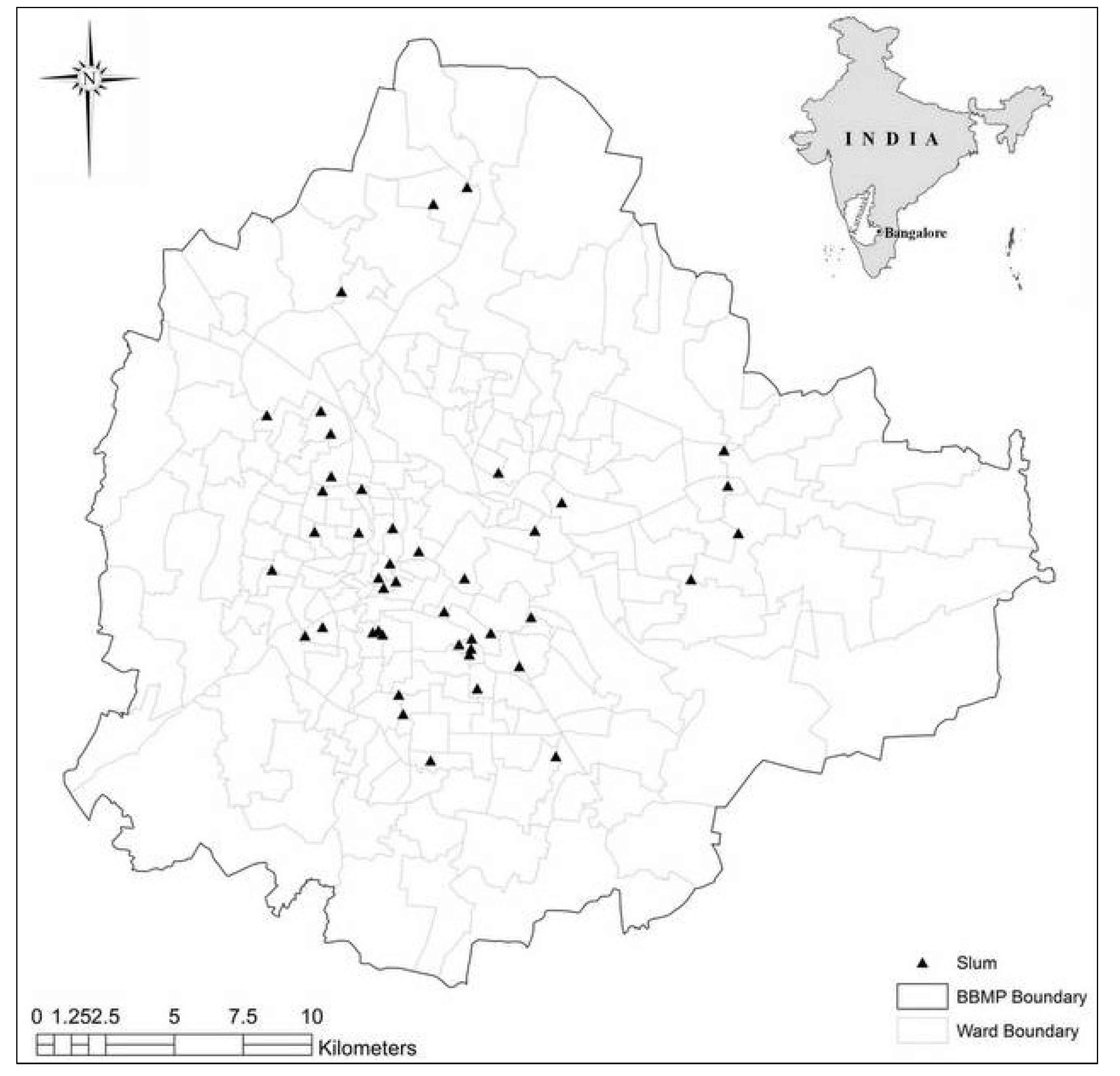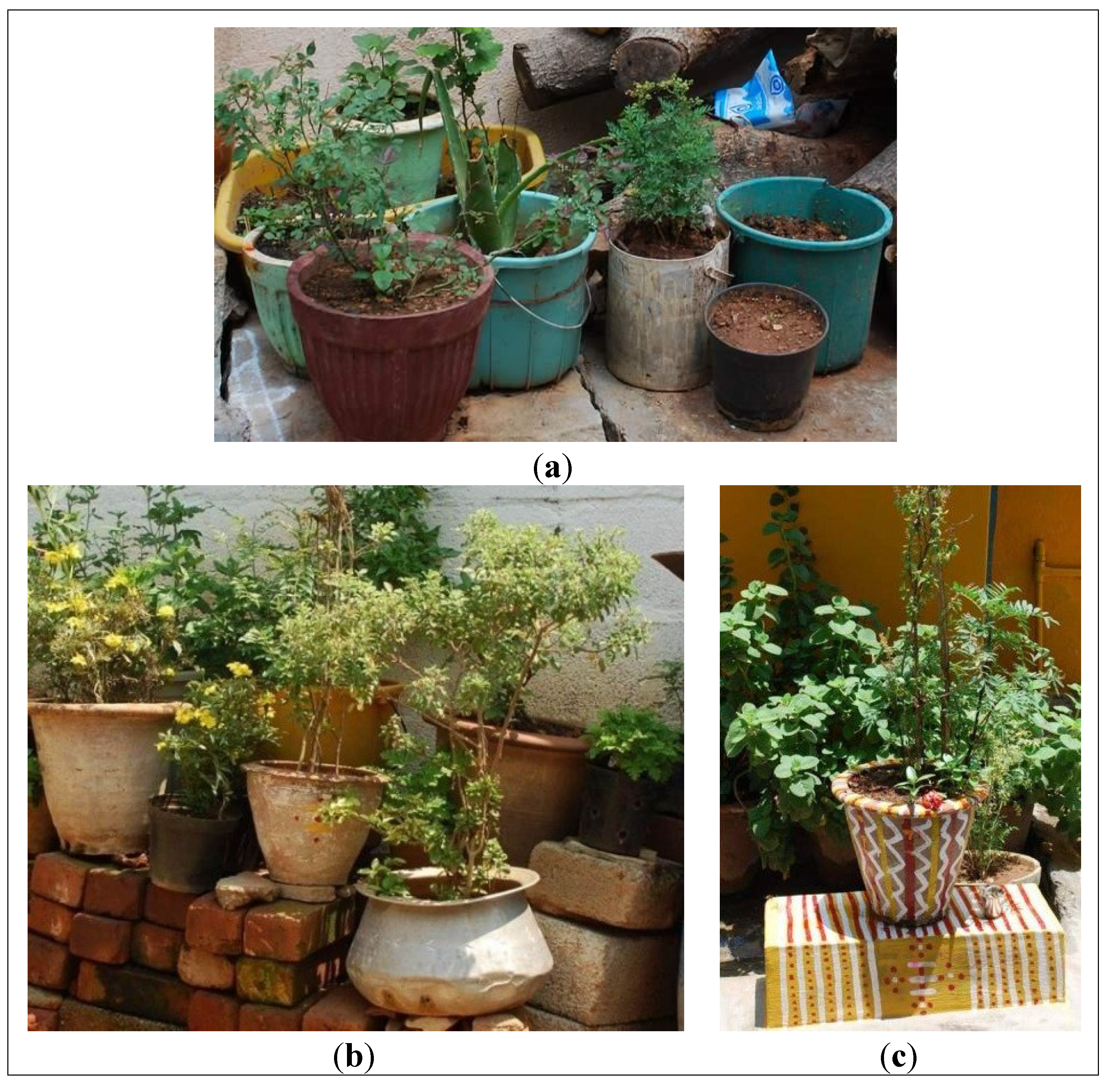Vegetation in Bangalore’s Slums: Boosting Livelihoods, Well-Being and Social Capital
Abstract
:1. Introduction
2. Study Area and Methods

3. Results
3.1. Species Attributes
| Scientific Name | Common Name | Relative Abundance | Uses | Activities Observed (Non-Exhaustive) |
|---|---|---|---|---|
| Moringa oleifera | Drumstick tree | 16.0 | Fruits Medicinal | Adults playing |
| Cocos nucifera | Coconut tree | 12.9 | Fruits | Fruit consumed |
| Azadirachta indica | Neem tree | 8.3 | Medicinal | Children playing |
| Ficus religiosa | Sacred fig | 7.6 | Sacred Medicinal | Children playing |
| Albizia saman | Rain tree | 6.5 | Ornamental Shade | Breaking stones |
| Muntingia calabura | Singapore cherry | 6.5 | Fruit | Fruit consumed |
| Pongamia pinnata | Pongam tree | 5.6 | Shade Medicinal | Fruit and leaves consumed |
| Mangifera indica | Indian mango tree | 4.0 | Fruit | Children playing |
| Swietenia macrophylla | Big-leaved mahogany | 3.3 | Shade | Playing carrom |
| Psidium guajava | Guava tree | 3.1 | Fruit | Making Brooms |

3.2. Sacred Species
| Scientific Name | Common Name | No. of Individuals |
|---|---|---|
| Ficus religiosa | Sacred fig | 32 |
| Azadirachta indica | Neem tree | 18 |
| Ficus racemosa | Cluster fig | 2 |
| Ficus religiosa + Azadirachta indica | Sacred fig + neem | 2 |
| Pithecellobium dulce | Manila tamarind | 2 |
| Albizia saman | Rain tree | 2 |
| Pongamia pinnata | Pongam tree | 2 |
| Delonix regia | Gulmohar | 1 |
| Gmelina arborea | Gumhar | 1 |
| Markhamia lutea | Nile tulip | 1 |
3.3. Utility of Tree Species
| Utility | Percentage of total tree population |
|---|---|
| Clothesline | 35.3 |
| Holy symbols | 6.9 |
| Wire support | 4.9 |
| Tent support | 4.5 |
| Photograph stand | 0.5 |
| Switch board support | 0.5 |
| Hoardings | 0.2 |
| Lamp post | 0.2 |
| Puncture shop | 0.2 |
| Storage area | 0.2 |
3.4. Green Preferences
| Tree of Choice | No. of Slums | Reason |
|---|---|---|
| None | 23 | No space/Ownership issues/Plenty of trees |
| Pongamia pinnata | 14 | Shade |
| Azadirachta indica | 7 | Shade/Health |
| Mangifera indica | 3 | Fruits |
| Michelia champaca | 2 | Fragrance/Flowers |
| Cocos nucifera | 1 | Compact tree with small basal area |
| Flowering trees | 1 | Flowers |
| Muntingia calabura | 1 | Fruits |
| Shade-giving | 1 | Shade |
| Syzigium cumini | 1 | Fruits |
3.5. Innovative Gardening

4. Discussion
4.1. Health and Well-Being
4.2. Boosting Livelihoods
4.3. Social Capital
5. Conclusions
Acknowledgments
Author Contributions
Supplementary Materials
Conflicts of Interest
References
- United Nations. World Urbanization Prospect: The 2011 Revision; United Nations: New York, NY, USA, 2012. [Google Scholar]
- TEEB Manual for Cities: Ecosystem Services in Urban Management. Available online: http://www.teebweb.org/publication/teeb-manual-for-cities-ecosystem-services-in-urban-management (accessed on 15 December 2013).
- Bowler, D.; Buyung-Ali, L. Urban greening to cool towns and cities: A systematic review of the empirical evidence. Landsc. Urban Plan. 2010, 97, 147–155. [Google Scholar] [CrossRef]
- Nowak, D.J.; Crane, D.E.; Stevens, J.C. Air pollution removal by urban trees and shrubs in the United States. Urban For. Urban Green. 2006, 4, 115–123. [Google Scholar] [CrossRef]
- Wong, N.H.; Tan, A.Y.K.; Tan, P.Y.; Chiang, K.; Wong, N.C. Acoustics evaluation of vertical greenery systems for building walls. Build. Environ. 2010, 45, 411–420. [Google Scholar] [CrossRef]
- Sugiyama, T.; Leslie, E.; Giles-Corti, B.; Owen, N. Associations of neighbourhood greenness with physical and mental health: Do walking, social coherence and local social interaction explain the relationships? J. Epidemiol. Community Health 2008, 62, e9. [Google Scholar] [CrossRef]
- Maas, J.; Verheij, R.A.; de Vries, S.; Spreeuwenberg, P.; Schellevis, F.G.; Groenewegen, P.P. Morbidity is related to a green living environment. J. Epidemiol. Community Health 2009, 63, 967–973. [Google Scholar] [CrossRef]
- Jaganmohan, M.; Vailshery, L.; Gopal, D.; Nagendra, H. Plant diversity and distribution in urban domestic gardens and apartments in Bangalore, India. Urban Ecosyst. 2012, 15, 911–925. [Google Scholar] [CrossRef]
- Cilliers, S.; Siebert, S.; Davoren, E.; Lubbe, R. Social Aspects of Urban Ecology in Developing Countries, with an Emphasis on Urban Domestic Gardens. In Applied Urban Ecology: A Global Framework; Richter, M., Weiland, U., Eds.; Blackwell Publishing Ltd.: West Sussex, UK, 2012; pp. 123–128. [Google Scholar]
- Kuo, F. Coping with poverty impacts of environment and attention in the inner city. Environ. Behav. 2001, 33, 5–34. [Google Scholar] [CrossRef]
- Van den Berg, A.E.; Maas, J.; Verheij, R.A.; Groenewegen, P.P. Green space as a buffer between stressful life events and health. Soc. Sci. Med. 2010, 70, 1203–1210. [Google Scholar] [CrossRef]
- Ninez, V. Working at half-potential: Constructive analysis of home garden programmes in the Lima slums with suggestions for an alternative approach. Food Nutr. Bull. 1985, 7, 1–5. [Google Scholar]
- Gallaher, C.M.; Kerr, J.M.; Njenga, M.; Karanja, N.K.; WinklerPrins, A.M.G.A. Urban agriculture, social capital, and food security in the Kibera slums of Nairobi, Kenya. Agric. Human Values 2013, 30, 389–404. [Google Scholar] [CrossRef]
- Van Leeuwen, E.; Nijkamp, P.; de Noronha Vaz, T. The multifunctional use of urban greenspace. Int. J. Agric. Sustain. 2010, 8, 20–25. [Google Scholar] [CrossRef]
- Krishna, A. Active Social Capital; Columbia University Press: New York, NY, USA, 2002. [Google Scholar]
- Rakodi, C. A livelihoods approach—Conceptual issues and definitions. In Urban Livelihoods: A People-Centred Approach to Reducing Poverty; Rakodi, C., Lloyd-Jones, T., Eds.; Earthscan: Sterling, VA, USA, 2002; pp. 3–22. [Google Scholar]
- Martin, K.S.; Rogers, B.L.; Cook, J.T.; Joseph, H.M. Social capital is associated with decreased risk of hunger. Soc. Sci. Med. 2004, 58, 2645–2654. [Google Scholar] [CrossRef]
- Aggarwal, S.; Butsch, C. Environmental and Ecological Threats in Indian Mega Cities. In Applied Urban Ecology: A Global Framework; Richter, M., Weiland, U., Eds.; Blackwell Publishing Ltd.: West Sussex, UK, 2012; pp. 66–81. [Google Scholar]
- Sudhira, H.S.; Ramachandra, T.V.; Subrahmanya, M.H.B. Bangalore. Cities 2007, 24, 379–390. [Google Scholar] [CrossRef]
- Jawaharlal Nehru National Urban Renewal Mission. Revised City Development Plan: Bangalore; Jawaharlal Nehru National Urban Renewal Mission: New Delhi, India, 2009; Volume 3. [Google Scholar]
- Nagendra, H.; Gopal, D. Street trees in Bangalore: Density, diversity, composition and distribution. Urban For. Urban Green. 2010, 9, 129–137. [Google Scholar] [CrossRef]
- Nagendra, H.; Gopal, D. Tree diversity, distribution, history and change in urban parks: Studies in Bangalore, India. Urban Ecosyst. 2011, 14, 211–223. [Google Scholar] [CrossRef]
- Sudha, P.; Ravindranath, N. A study of Bangalore urban forest. Landsc. Urban Plan. 2000, 47, 47–63. [Google Scholar] [CrossRef]
- National Institute of Urban Affairs. Urban Poverty Reduction Strategy for Bangalore; National Institute of Urban Affairs: New Delhi, India, 2008. [Google Scholar]
- Nagendra, H.; Nagendran, S.; Paul, S.; Pareeth, S. Graying, greening and fragmentation in the rapidly expanding Indian city of Bangalore. Landsc. Urban Plan. 2012, 105, 400–406. [Google Scholar] [CrossRef]
- Neginhal, S. Golden Trees, Greenspaces, and Urban Forestry; Self published: Bangalore, India, 2006. [Google Scholar]
- Krishen, P. Trees of Delhi; Penguin Books: New Delhi, India, 2006. [Google Scholar]
- Kehimkar, I. Common Indian Wild Flowers; Oxford University Press: Mumbai, India, 2000. [Google Scholar]
- Kurian, D.J. Plants that Heal; Oriental Watchman Publishing House: Pune, India, 2004. [Google Scholar]
- Kuo, F.; Sullivan, W. Aggression and violence in the inner city effects of environment via mental fatigue. Environ. Behav. 2001, 33, 543–571. [Google Scholar] [CrossRef]
- Martin, C.A.; Warren, P.S.; Kinzig, A.P. Neighborhood socioeconomic status is a useful predictor of perennial landscape vegetation in residential neighborhoods and embedded small parks of Phoenix, AZ. Landsc. Urban Plan. 2004, 69, 355–368. [Google Scholar]
- Lubbe, C.S.; Siebert, S.J.; Cilliers, S.S. Political legacy of South Africa affects the plant diversity patterns of urban domestic gardens along a socio-economic gradient. Sci. Res. Essays 2010, 5, 2900–2910. [Google Scholar]
- Guite, H.F.; Clark, C.; Ackrill, G. The impact of the physical and urban environment on mental well-being. Public Health 2006, 120, 1117–1126. [Google Scholar] [CrossRef]
- Pandey, C.B.; Lata, K.; Venkatesh, A.; Medhi, R.P. Diversity and species structure of home gardens in South Andaman. Trop. Ecol. 2006, 47, 251–258. [Google Scholar]
- Gupta, H.; Baghel, A. Infant mortality in the Indian slums: Case studies of Calcutta metropolis and Raipur city. Int. J. Popul. Geogr. 1999, 5, 353–366. [Google Scholar] [CrossRef]
- Vashishtha, V. Rising urbanization of poverty a blot on the shining armor India urban poverty report 2009. Indian Pediatr. 2009, 46, 875–876. [Google Scholar]
- World Health Organization (WHO). Traditional Medicine Strategy 2002–2005; WHO: Geneva, Switzerland, 2002. [Google Scholar]
- Kassam, K.-A.; Karamkhudoeva, M.; Ruelle, M.; Baumflek, M. Medicinal Plant Use and Health Sovereignty: Findings from the Tajik and Afghan Pamirs. Hum. Ecol. Interdiscip. J. 2010, 38, 817–829. [Google Scholar] [CrossRef]
- Sitaramam, V.; Jog, S.; Tetali, P. Ecology of Ficusreligiosa accounts for its association with religion. Curr. Sci. 2009, 97, 637–640. [Google Scholar]
- Singh, D.; Singh, B.; Goel, R.K. Traditional uses, phytochemistry and pharmacology of Ficusreligiosa: A review. J. Ethnopharmacol. 2011, 134, 565–583. [Google Scholar] [CrossRef]
- Pascal, P.; Mwende, E. A Garden in a Sack: Experiences in Kibera, Nairobi. Urban Agric. Mag. 2009, 21, 38–40. [Google Scholar]
- Bebbington, A.; Perreault, T. Social Capital, Development, and Access to Resources in Highland Ecuador. Econ. Geogr. 1999, 75, 395–418. [Google Scholar] [CrossRef]
- Fraser, E. Urban ecology in Bangkok, Thailand: Community participation, urban agriculture and forestry. Environments 2002, 30, 37–50. [Google Scholar]
- Kweon, B.-S.; Sullivan, W.C.; Wiley, A.R. Green Common Spaces and the Social Integration of Inner-City Older Adults. Environ. Behav. 1998, 30, 832–858. [Google Scholar] [CrossRef]
- Cattell, V.; Dines, N.; Gesler, W.; Curtis, S. Mingling, observing, and lingering: Everyday public spaces and their implications for well-being and social relations. Health Place 2008, 14, 544–561. [Google Scholar] [CrossRef]
- Sampson, R.J.; Raudenbush, S.W.; Earls, F. Neighborhoods and violent crime: A multilevel study of collective efficacy. Science 1997, 277, 918–924. [Google Scholar] [CrossRef]
- Sambisa, W.; Angeles, G.; Lance, P.M.; Naved, R.T.; Thornton, J. Prevalence and correlates of physical spousal violence against women in slum and nonslum areas of urban Bangladesh. J. Interpers. Violence 2011, 26, 2592–2618. [Google Scholar] [CrossRef]
- Mchombu, K. Sharing Knowledge for Community Development and Transformation: A Handbook; Oxfam Canada: Ottawa, ON, Canada, 2004. [Google Scholar]
- Berkes, F.; Colding, J.; Folke, C. Rediscovery of traditional ecological knowledge as adaptive management. Ecol. Appl. 2000, 10, 1251–1262. [Google Scholar] [CrossRef]
- Schusler, T.M.; Decker, D.J.; Pfeffer, M.J. Social Learning for Collaborative Natural Resource Management. Soc. Nat. Resour. 2003, 16, 309–326. [Google Scholar] [CrossRef]
- Verma, A.; Singhal, A.; Singh, D. Local health wisdom of rural women using medicinal plants. Indian J. Tradit. Knowl. 2010, 9, 289–293. [Google Scholar]
- Barthel, S.; Folke, C.; Colding, J. Social-ecological memory in urban gardens—Retaining the capacity for management of ecosystem services. Glob. Environ. Chang. 2010, 20, 255–265. [Google Scholar] [CrossRef]
© 2014 by the authors; licensee MDPI, Basel, Switzerland. This article is an open access article distributed under the terms and conditions of the Creative Commons Attribution license (http://creativecommons.org/licenses/by/3.0/).
Share and Cite
Gopal, D.; Nagendra, H. Vegetation in Bangalore’s Slums: Boosting Livelihoods, Well-Being and Social Capital. Sustainability 2014, 6, 2459-2473. https://doi.org/10.3390/su6052459
Gopal D, Nagendra H. Vegetation in Bangalore’s Slums: Boosting Livelihoods, Well-Being and Social Capital. Sustainability. 2014; 6(5):2459-2473. https://doi.org/10.3390/su6052459
Chicago/Turabian StyleGopal, Divya, and Harini Nagendra. 2014. "Vegetation in Bangalore’s Slums: Boosting Livelihoods, Well-Being and Social Capital" Sustainability 6, no. 5: 2459-2473. https://doi.org/10.3390/su6052459
APA StyleGopal, D., & Nagendra, H. (2014). Vegetation in Bangalore’s Slums: Boosting Livelihoods, Well-Being and Social Capital. Sustainability, 6(5), 2459-2473. https://doi.org/10.3390/su6052459





